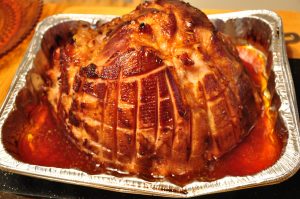The ancient Romans, who sacrificed a pig to their god Saturn about the same time Christmas is celebrated nowadays, are probably the starters of a Christmas tradition still alive in some parts of the world. This is a recipe for a boneless, lightly salted Finnish-style ham, popular since about the 1940s, before which Finns used to eat several kinds of meats during Christmas.

This is often eaten with traditional Christmas cuisine, including baked potatoes, red wine, and potato, carrot, and rutabaga casseroles, as well as during the night or in the morning and in-between ‘proper’ meals with bread, mustard and milk. Ham goes well with almost anything. If you have been eating ham for several days with mustard, try chili for a change.
Ingredients
1 7-10 kg ham, lightly salted, boneless
mustard
breadcrumbs
Procedure
1. If ham is frozen, thaw it in its plastic package, for 3 days in the refrigerator for a 7kg ham, 5 days for a 10kg ham. A 10kg ham is considered better-tasting as the pig has gotten bigger.
2. Before putting the ham in the oven, take it out from the refrigerator and let come closer to room temperature. If you intend to put the ham in the oven in the evening, take it out during the early morning. The ham should be about 10 degrees C (50 F) when you put it in the oven.
3. Use a wet paper towel to clean the ham a bit; then dry it.
4. Place ham on baking tray in oven, with some water on the tray. Or, if you have a large roasting bag, there is no need for water.
5. Note: do not use only the grill as it lets drop all the liquid from the ham, messing up your oven if the roasting bag fails. However, you can use the grill and put the ham on it and baking tray beneath that. An aluminum foil can also be used on the baking tray.
6. Preheat oven to 200 °C (you can skip this if you are not worried about the possible bacteria on the ham) and let ham roast in the warm oven for half an hour, then turn temperature down.
7. Cook at 100-125 °C, for about 1 hour/kilo, so a 7 kg ham will take 7 hours or more, until meat thermometer shows 75-80 °C. ‘Traditional’ ham is ready at 80 °C but most take the ham out of the oven at 77 °C or so, when the ham has more water left in it and is considered tastier.
8. The use of a meat thermometer is recommended because the actual temperature of an oven commonly varies from its setting; thus the ham can be severely under- or overcooked if you do not use a thermometer. Thermometer should be placed in the middle of the ham. Be careful that it does not touch the oven walls. You can test if the thermometer works properly before using it by dipping it in boiling water – it should show about 100 °C.
9. After you take the ham out of the oven, wait a little while before removing the thermometer. It is recommended you do not pour the liquid from the bag or baking tray down the drain.
10. Wait until ham is cool enough to handle, then glaze it with mustard and breadcrumbs. First remove the rind from the ham, then cover the ham with mustard, then with breadcrumbs. Put in 250 °C oven for 10 minutes.
11. Ham is ready to eat when it has cooled down a bit. This makes about enough for 3 or 4 people for a week, but if you think you will not eat it all within a week, freeze the rest.
Notes, tips, and variations
It is possible to salt a ham yourself, if you buy ham from a farm or butcher or buy a pig in time to fatten it for Christmas. There are several methods available; here is one that is called tönkkösuolaus: Use a 10kg ham, put 1,8 kg of large crystal salt into 10 liters of water which is near or slightly below 0c, ham must be completely submerged, let be there for two months, changing the water from time to time, during the last week you can keep ham in water only, if you want it to be slightly less salty).
Several people swear by sauna-cooked ham, in which case you will put the ham in a sauna instead of an oven (glazing still done in oven), it will take maybe 12-24 hours for a ham in a 100 °C sauna, several days in a 80 °C sauna. Use a meat thermometer if you use a sauna to cook a ham and remember to have something beneath the ham collecting all the liquid. Often people also use a wood-burning stove to cook a ham, this method is hardest as you can not use a meat thermometer easily with one, so unless you have good instructions to the very oven you have (or have a spare ham just in case), this would not be recommended for first-time Christmas ham lovers.
Retrieved from “http://en.wikibooks.org/w/index.php?title=Cookbook:Christmas_Ham&oldid=2686518”
